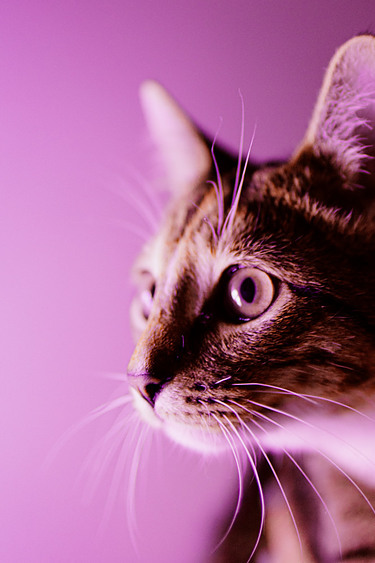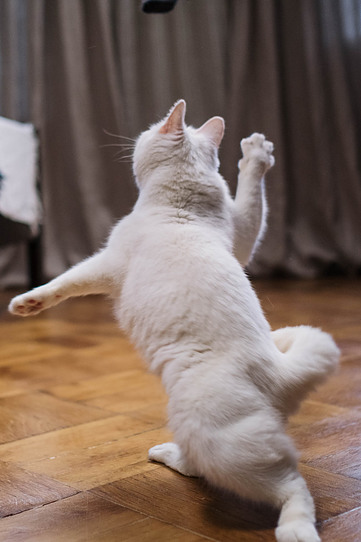Hello, Cat Enthusiasts!
Feline behaviour is not easy to decode – it may seem unpredictable and weird, often in a good and funny way. However, there are behaviours that may indicate underlying problems and should never be ignored. In this article we are going to focus on behaviours of concern.
Behaviour is the way cats communicate and respond to external and internal stimuli. Typically, feline behaviour is organized, consistent and serves certain functions. However, sometimes cats develop behaviours that don’t have apparent reason or function. Such strange behaviours can become a cause of concern and need further investigation as they can be associated with hidden medical or psychological conditions or other negative factors, such as environmental and social issues.
In cats, many diseases develop slowly and don’t have clear symptoms. Cats may seem healthy even if they’re ill, stressed or in pain – that is why chronic diseases often go undiagnosed until they reach terminal stages. When physical symptoms are absent or subtle, unusual behaviour can be the only sign (or one of the first signs) that something is wrong. Therefore, recognizing and addressing behaviours of concern as soon as possible can protect a cat’s health and even save it’s life. Here are 5 cat behaviours to worry about.
1. Eating Non-Food Items
Consuming non-edible items isn’t normal for cats. Chewing, mouthing or ingesting foreign objects, especially if the behaviour is consistent and the cat is older than around 6 months, is a sign of compulsive eating disorder also known as pica syndrome.
According to WikiVet, this condition often stem from wool sucking behaviour which is characterized by sucking and chewing of woolly objects, such as blankets or sweaters, or even familiar cats’ or dogs’ body parts (tail, paws, area around the neck) for comfort.
Wool sucking is considered a natural juvenile behaviour similar to thumb sucking in children, but if it persists in an adult cat, it may be considered abnormal. This behaviour begins from mouthing wool and can progress to chewing other fabrics, leather, paper or cardboard. Over time wool sucking can generalize and transition into pica which causes the cats to engage in chewing (and in some cases swallowing) other items, such as cat litter, houseplants, plastic, strings, electric cords, etc.
However, there is a variety of underlying problems besides wool sucking that can cause pica. Possible culprits are lack of environmental stimulation, stress, nutritional deficiencies or medical conditions, including internal parasites, viruses, dental issues, hyperthyroidism, hepatic encephalopathy and diabetes.
Pica is a potentially life-threatening condition that can cause a range of digestive problems from stomach upset to gastrointestinal obstruction.
If you suspect pica in your cat, the best thing you can do to help is take it to the veterinarian to determine the cause of pica behaviour and provide the right treatment.
If your cat’s pica doesn’t have a medical cause, it might be linked to a psychological problem so you might also need to work with a behavioural specialist to investigate and manage your cat’s condition.
2. Eating with Its Paws
Using a paw as a spoon or removing food from the bowl with a paw is a harmless behaviour in itself but may indicate that the cat feels uncomfortable eating normally because it doesn’t like something about its feeding bowl, feel unsafe or experience physical discomfort.
Cats can be fussy about food and water in general and their bowls in particular. If the cat eats with its paw, it might mean that it struggles to reach the food because the bowl is too small or too deep.
Also, some cats avoid putting their faces in the bowl because they have whisker fatigue – an uncomfortable overstimulation of whiskers’ sensory system when whiskers touch the brim.
Another possible reason is the wrong location of the bowl. Cats feel vulnerable while eating and if the cat doesn’t feel secure with its surroundings, it might feel more confident when it keeps upright posture and can look around while eating.
Finally, cats may be reluctant to reach down for their food if they feel stiffness or pain which can be caused by musculoskeletal disorders or trauma, such as arthritis or joint luxation.
Although this behaviour is not something that requires immediate professional help, you can try to make your cat feel more comfortable eating normally by swapping its bowl for wide and shallow dish or moving the bowl to more quiet and private place.
If this doesn’t help and this weird behaviour concerns you, be sure to mention it next time you visit your veterinarian. When it comes to clinical examination and building accurate history, your observations can play a critical role. Of course, if you notice other signs of discomfort in your cat, don’t delay your visit.
3. Head Pressing
Head pressing is a behaviour that always mean something is seriously wrong.
It is characterized by pressing the face against the corner, wall or other flat surface forcefully and for no apparent reason.
This behaviour happens repeatedly and continually while the cat is awake.
Head pressing is an acute neurological symptom and has nothing to do with normal bonding behaviours, such as head bunting or face rubbing.
Head pressing can be caused by: 
- head trauma
- stroke
- forebrain disease
- chronic liver disease
- metabolic disorders (Vitamin B1 deficiency, hepatic encephalopathy, hypoglycemia, hypo- or hypernatremia)
- infection
- bacterial (Tyzzer’s disease)
- fungal (cryptococcosis, aspergillosis, blastomycosis)
- protozoal (toxoplasmosis)
- viral (FeLV, FIV)
- poisoning (rat poison, pesticides, antifreeze)
and is usually accompanied by other symptoms of nervous system damage, such as restlessness, cognitive changes, incoordination, lethargy, colliding with objects, seizures.
All underlying conditions related to head pressing are medical emergencies.
If you think that your cat is head pressing, transport it to a veterinary facility immediately.
4. Staring
Cats are famous for their mesmerizing eyes and curious ability to stare unblinkingly at nothing in particular. However, when the cat stares intently at the wall or simply into space seemingly for no reason, it can be a little alarming.
Usually, this behaviour is a completely normal part of cat hunting repertoire but in some instances it can be caused by an underlying problem.
Staring at the wall might mean the cat is engaged in hunt and is listening out for rustling in the walls or curious noises outside, or it might be focused on a tiny insect or shadows on the walls.
This hunting behaviour can be accompanied by other signs that the cat is intrigued, such as alert ears, chirping and swishing tail movements. Such a hunt can easily be interrupted by household noises, voices or other events.
However, if the cat is staring at the wall for no reason on a regular basis, it can be a sign of psychological disorder or physical problem, such as compulsive disorder caused by psychological distress or lack of stimulation; cognitive dysfunction syndrome; vision loss; focal seizures caused by liver disease, infection, diabetes, epilepsy, brain tumor, stroke or poisoning.
This problematic staring can be accompanied by other symptoms, such as housesoiling, disorientation, changes in sleep habits, etc., and can progress over time in duration and frequency of episodes.
If you notice your cat staring at nothing and it concerns you, just call its name while it is staring. If the cat doesn’t react to your voice and such episodes are consistent, it’s best to mention this to your veterinarian, especially if you see other concerning changes in your cat’s appearance or behaviour.
5. Cat Zoomies (FRAP)
Frenetic Random Activity Periods (FRAPs) or zoomies are characterized by chasing invisible prey, rapid random jumping, scratching, climbing, etc., and can be accompanied with loud meowing.
Zoomies don’t have any particular reason but often they seem to be triggered by routine activities, such as using of litter box, eating, play, scratching or grooming. The episodes of this behaviour are short and begin and end abruptly.
FRAPs is considered a normal behaviour but in some cases it might indicate that the cat doesn’t meet its environmental or social needs or suffers from stress or disease.
Zoomies are more common in kittens and young cats. Such episodes of hyperactivity help them practice their hunting skills, get some additional exercise and burn some energy.
However, they might occur as a way to release excessive nervous energy resulting from frustration, anxiety, or depression caused by lack of stimulation or social issues.
If zoomies are a part of the cat’s eating or litter box routine, they might be a sign of discomfort caused by gastrointestinal problems, such as constipation or pain.
Alternatively, FRAPs might indicate that the cat experiences itching and irritation caused by external parasites, such as fleas, lice or mites, especially if they are linked to grooming routine and the cat is frantically rolling on it’s back or running in circles during the episodes.
Finally, zoomies might be caused by hyperthyroidism, especially if the cat is older than 12 years of age and begins to display such a behaviour suddenly. In this case, increased activity can be accompanied by weight loss, nervousness, bad coat condition.
If this behaviour is an issue in itself, you can try to redirect it to something more productive like play or exploration.
Consider creating a playtime routine and enrich your cat’s environment with objects to explore, such as toys, food puzzles, additional vantage points, etc.
If your cat prefers to zoom at night, you might also need to adjust its sleeping schedule by creating a bedtime routine.
Make sure your cat has sufficient resources and positive social environment.
Don’t try to interrupt the episodes as this may increase the risk your cat injures itself or breaks something in the house.
FRAPs in itself is a relatively harmless behaviour, at least for cats. They seem to perfectly know what they are doing during their crazy races. However, if this behaviour is not typical for your cat, the episodes become more frequent, progress in duration and intensity and if this is accompanied by signs of distress, it’s best to discuss it with a veterinarian.
Final Thoughts
Needless to say that this article doesn’t include descriptions of all known cat behaviours to worry about.
In fact, anything different from the cat’s individual repertoire of behaviours can be considered abnormal and therefore might become a cause of concern and a reason to at least pay close attention to the cat’s appearance and habits.
Always remember that life and health of your cat is in your hands. Take any weird behaviours seriously, no matter how minor, insignificant or funny they may seem.
If you notice your cat acting weird and your intuition tells you that something’s wrong but you’re still in doubt, there’s a quick way to check yourself.
Ask yourself two questions:
1. Are there any changes in my cat’s eating, drinking, sleeping or litter box habits or other signs that also concern me?
2. Can I recall any recent event that might cause the behaviour? For example, changes in your household or your lifestyle, conflicts between the cat and your other animals, guests visits, etc.
If the answers are 1. Yes and 2. No., contact your veterinarian.
Also, consider taking video of your cat’s behaviour and writing down the date, time and duration of the episode and frequency of episodes to show the veterinarian.
Well-informed, conscientious and vigilant cat parents can dramatically facilitate diagnostic process so the disease can be spotted and treated at an early stage. This helps to prevent complications and allow their cats return to normal life quickly.
Ultimately, cat owners are responsible for their cat’s wellbeing and access to veterinary treatment.
If you have something to add or wish to share your experience, please leave a comment!
Thank You For Reading!

